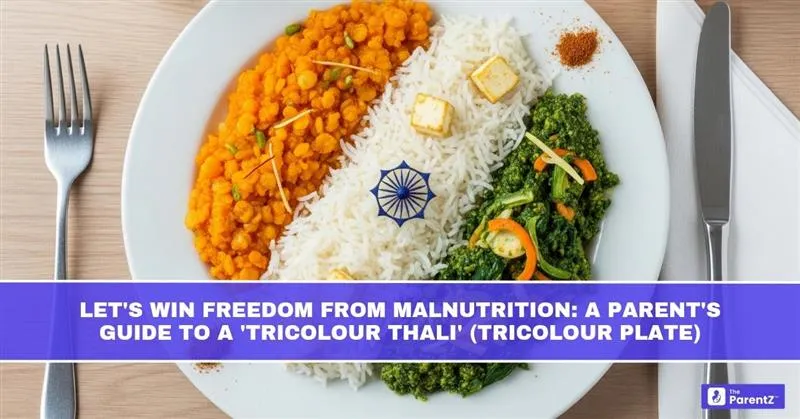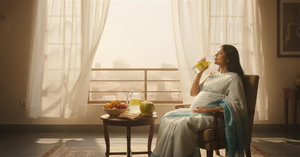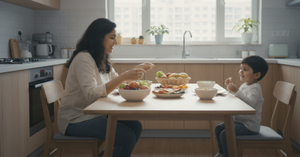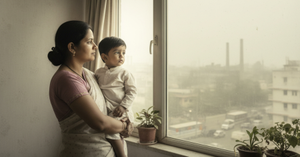As India celebrates Independence Day, it is time for families to reflect on another kind of freedom, freedom from malnutrition. While the country has made significant progress in many areas, childhood malnutrition continues to affect millions of Indian children. According to the National Family Health Survey (NFHS-5), one in every three children under five is underweight or stunted. Malnutrition silently weakens a child’s ability to grow, learn, and fight infections.
This Independence Day, parents can pledge to offer their children the gift of good health by adopting a simple, symbolic, and science-backed approach, the ‘Tricolour Thali’ or Tricolour Plate. Inspired by the Indian flag, this idea helps create a balanced, nutritious meal using locally available foods in orange, white, and green, representing health, diversity, and unity.
What Is a Tricolour Thali?
A ‘Tricolour Thali’ is a meal plate that includes three main food colour groups:
- Orange or Yellow Foods: Energy-rich and immunity-boosting
- White Foods: Protein and calcium-rich for growth
- Green Foods: Fibre, iron, and vitamins for blood and brain development
This simple visual tool helps parents remember to include a variety of nutrients at every meal. The colours are not just symbolic but rooted in dietary science, and align well with guidelines from the Indian Academy of Paediatrics (IAP), WHO, and the Ministry of Health and Family Welfare.
Orange Section: Energy and Immunity
Orange-coloured foods are rich in beta-carotene (Vitamin A), Vitamin C, and antioxidants. They help improve eyesight, skin health, and immunity.
Some everyday orange or yellow foods to include are:
- Carrots, pumpkin, yellow capsicum, and sweet potato
- Mango, papaya, orange, and ripe banana
- Turmeric in curries or golden milk
- Yellow moong dal and besan-based dishes
These foods not only provide vitamins but are energy-rich, which is essential for undernourished or highly active children. Pumpkin paratha, carrot poha, and papaya smoothies are simple ways to include this colour on your child’s plate.
White Section: Proteins, Calcium, and Gut Health
White foods may appear bland, but are vital for growth and muscle development. They are often rich in protein, healthy fats, and calcium.
Include the following in your child’s daily diet:
- Milk, curd, paneer, and buttermilk
- Eggs and egg whites (where acceptable)
- Rice, poha, idli, dosa, and upma made from rice or rava
- White beans, chana, and cashews in moderation
- Coconut and sesame seeds
These foods provide protein, essential for building tissues, and calcium for strong bones. Even a simple curd rice with boiled egg or paneer stuffed roti covers this part of the plate beautifully.
Green Section: Iron, Fibre, and Brain Nutrition
Green vegetables and herbs are essential for blood formation, preventing anaemia, and improving gut health. They also offer fibre, which supports digestion and prevents constipation.
Use the following easily available greens:
- Palak (spinach), methi (fenugreek), and bathua
- Cabbage, green capsicum, and green peas
- Curry leaves, coriander, and mint in chutneys
- Drumstick leaves in dosa or dal
- Green banana and green moong dal
Iron deficiency is a leading cause of childhood anaemia in India. Green leafy vegetables cooked with vitamin C-rich foods (like lemon or tomato) help increase iron absorption. Palak dal, green moong khichdi, and methi thepla are great additions to a child’s meal.
How to Assemble a Balanced Tricolour Plate
To make this practical, aim for a meal that includes:
- One orange or yellow item (such as pumpkin sabzi or carrot salad)
- One green vegetable or dal (like palak paneer or moong dal)
- One white component (such as rice, curd, or egg)
This simple visual rule ensures the inclusion of diverse nutrients at each meal. You can adapt the idea across breakfast, lunch, or dinner. For example:
Breakfast Tricolour Thali:
Methi thepla (green) + curd (white) + mango slices (orange)
Lunch Tricolour Thali:
Moong dal khichdi (yellow) + palak sabzi (green) + boiled egg (white)
Dinner Tricolour Thali:
Pumpkin soup (orange) + rice (white) + cabbage stir-fry (green)
By rotating ingredients and seasonal vegetables, you keep the meals interesting and affordable.
Tips to Tackle Common Feeding Challenges
- If your child resists vegetables, try sneaking them into parathas, dosas, or cheelas
- Involve your child in shopping, washing, or arranging colourful foods, they are more likely to eat what they help prepare
- Avoid force-feeding. Offer variety and let the child choose from among healthy options
- Use spices, herbs, and textures to make foods tasty without relying on packaged snacks
- Limit tea, coffee, or aerated drinks with meals, as they reduce nutrient absorption
- Serve smaller, frequent meals if your child has a small appetite
The Role of Fortified Foods and Supplements
In cases where a natural diet alone is insufficient, the Ministry of Health recommends the use of:
- Fortified rice and flour in mid-day meals
- Vitamin A, iron, and deworming supplements under ICDS
- Fortified milk with added Vitamin D and calcium
If your child is underweight or recovering from illness, your paediatrician may also recommend calorie-dense nutrition supplements or therapeutic foods. These must be used under medical supervision.
What Parents Should Remember
- Nutrient-rich does not mean expensive. A ₹40 seasonal vegetable can be as powerful as any packaged snack
- Consistency is more important than perfection. A balanced thali 4–5 days a week already makes a difference
- Homemade food is more digestible and trusted, especially for young children
- Micronutrients like iron, zinc, and vitamin A play a large role in cognitive development, include them daily
- Underweight children need not just calories, but quality protein and micronutrients
When to Seek Medical Help
- If your child is losing weight or not gaining appropriately for age
- If there is persistent lack of appetite, tiredness, or frequent infections
- If your child has signs of anaemia such as pale skin, irritability, or poor school performance
- If you are unsure about portion sizes or need help planning a nutrition recovery diet
Consult a paediatrician or clinical dietitian for a personalised meal plan if needed.
Conclusion
This Independence Day, let us not just hoist the flag but also raise a plate filled with nutrition, colour, and hope. The Tricolour Thali is more than a symbolic gesture. It is a conscious step towards ending hidden hunger, boosting immunity, and shaping the future of our children.
Nutrition is not a privilege. It is a right. And as caregivers, we can exercise this right every day with awareness, intention, and love.
Let food be the first freedom we give our children.









Be the first one to comment on this story.